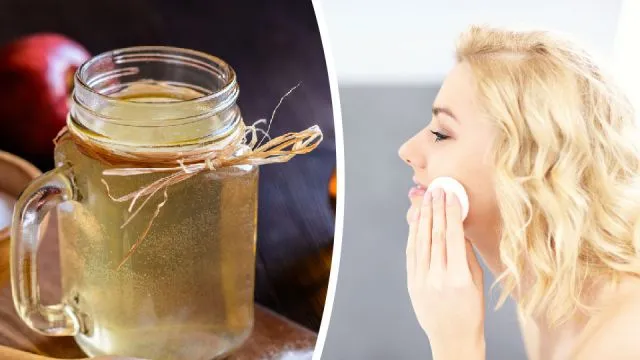
- Share on Facebook40
- Share on Pinterest
- Share on Twitter
If you’re prone to breakouts, then you likely have a higher pH balance. This means you’ll need a morning and night beauty routine that lowers your pH. Well, look no further than your kitchen. Apple cider vinegar may just be the solution.
Research suggests that pimples or stubborn acne thrive on alkaline skin. Apple cider vinegar, often consumed internally for weight loss, makes an ideal toner for the skin. It can lower the skin’s pH — and do so much more — in just weeks! Here’s how.
The link between pH and acne
One of the main reasons you may be developing acne and experiencing breakouts is because of your skin’s pH. Skin pH plays an important role in the health of your skin. In fact, changes in pH can contribute to several skin diseases, including acne according to a study published in the journal Europe PMC.
The study looked at the link between the pH level of skin and the age, and between the pH level and the development of acne. Researchers also evaluated the difference in pH between males and females. Skin pH was measured using the skin-pH-meter. What they found was that females had a higher pH than the male acne patients.

Meanwhile, the “T-zone” had a higher pH than the “U-zone.” The “T-Zone” is made up of the forehead, nose and bridge. The “U-zone” is the chin area. A high pH, which can lead to acne, means your pH is too alkaline.
- The pH scale runs from zero to 14, with zero being highly acidic and 14 being highly alkaline.
- In the middle of the scale sits seven, which is considered neutral.
- Normal pH in the human body should be more acidic at four to 6.5.
Researchers concluded that to successfully treat acne you have to maintain the pH balance between acid and alkaline. This environment is known as the “acid mantle,” which help skin cells function. Healthy skin pH level is linked to new cell growth and if the conditions aren’t right, the skin cells won’t multiply. Additionally, proper pH kills bacteria before it enters the body. Needless to say, the presence of bacteria is a major factor in the development of acne.
Apple cider vinegar as a toner
Here’s where apple cider vinegar (ACV) comes into play. ACV is made from organic apples during a two-step process. In the first step, crushed apples are blended with yeast, which ferments the sugars and turns them into alcohol. In the second step, bacteria are added to the solution, which further ferments the alcohol and turns it into acetic acid. Acetic acid is the main active compound in ACV.

Cleansing with a pH-balanced product like ACV twice a day is integral to maintaining clear skin. Research suggests that ACV can help kill pathogens, including bacteria. Additionally, ACV has a pH of three and when diluted into a toner, the acidity helps bring your skin’s pH back to its normal levels. Thus, clearing your skin. But even beyond balancing your pH, it also has additional benefits for the skin such as:
- Exfoliating dead cells
- Lightening sun and age spots
- Fading acne scars
- Minimizing the appearance of pores
Make your own apple cider vinegar toner
ACV is highly acidic. The main ingredient is acetic acid, which is why you should always dilute your ACV with purified water. Use an organic raw unfiltered ACV, preferably with the “mother” inside. The “mother” is the naturally occurring strand-like enzymes found only in raw, unfiltered apple cider vinegar.
Ingredients:
- 1 part organic apple cider vinegar
- 2 part clean filtered water
Instructions:
- Pour ACV into a glass jar or container.
- Add filtered or distilled water.
- Add the cap and shake to combine the mixture.
- With a cotton ball or pad, apply the toner to your freshly cleansed skin. Avoid the eye area.
- Allow to dry and apply moisturizer as per usual.
- Shake ACV toner well before each use. Store in a cool, dry, dark place.

Because your skin is unique, you may want to play around with the ratios of vinegar to water. For instance, you can begin by adding 1:3 or 1:4 ratio of vinegar to water. Increase the vinegar if needed and see how your skin responds. While you may not enjoy the smell of ACV on your face. Once the toner dries, the smell almost completely dissipates.
Discover 81 more ways to use ACV in this FREE book! =>
— Katherine Marko
- Share on Facebook40
- Share on Pinterest
- Share on Twitter

